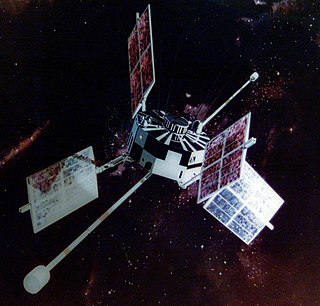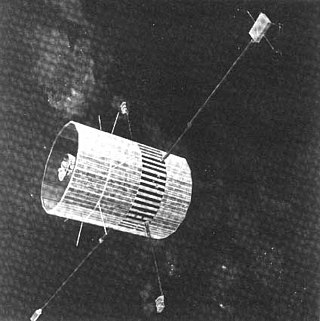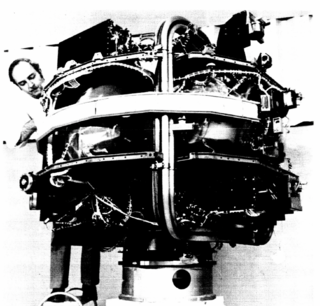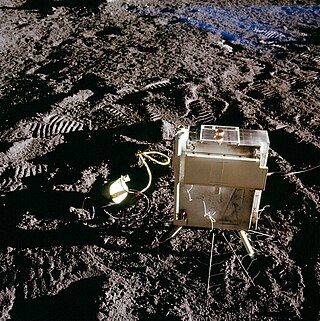
Explorer 35,, was a spin-stabilized spacecraft built by NASA as part of the Explorer program. It was designed for the study of the interplanetary plasma, magnetic field, energetic particles, and solar X-rays, from lunar orbit.

Explorer 54, also called as AE-D, was a NASA scientific satellite belonging to series Atmosphere Explorer, being launched on 6 October 1975 from Vandenberg Air Force Base board a Thor-Delta 2910 launch vehicle.

Explorer 18, also called IMP-A, IMP-1, Interplanetary Monitoring Platform-1 and S-74, was a NASA satellite launched as part of the Explorer program. Explorer 18 was launched on 27 November 1963 from Cape Canaveral Air Force Station (CCAFS), Florida, with a Thor-Delta C launch vehicle. Explorer 18 was the first satellite of the Interplanetary Monitoring Platform (IMP). Explorer 21 (IMP-B) launched in October 1964 and Explorer 28 (IMP-C) launched in May 1965 also used the same general spacecraft design.

Explorer 14, also called EPE-B or Energetic Particles Explorer-B, was a NASA spacecraft instrumented to measure cosmic-ray particles, trapped particles, solar wind protons, and magnetospheric and interplanetary magnetic fields. It was the second of the S-3 series of spacecraft, which also included Explorer 12, 14, 15, and 26. It was launched on 2 October 1962, aboard a Thor-Delta launch vehicle.

The ISEE-1 was an Explorer-class mother spacecraft, International Sun-Earth Explorer-1, was part of the mother/daughter/heliocentric mission. ISEE-1 was a 340.2 kg (750 lb) space probe used to study magnetic fields near the Earth. ISEE-1 was a spin-stabilized spacecraft and based on the design of the prior IMP series of spacecraft. ISEE-1 and ISEE-2 were launched on 22 October 1977, and they re-entered on 26 September 1987.

The ISEE-2 was an Explorer-class daughter spacecraft, International Sun-Earth Explorer-2, was part of the mother/daughter/heliocentric mission. ISEE-2 was a 165.78 kg (365.5 lb) space probe used to study magnetic fields near the Earth. ISEE-2 was a spin-stabilized spacecraft and based on the design of the prior IMP series of spacecraft. ISEE-1 and ISEE-2 were launched on 22 October 1977, and they re-entered on 26 September 1987.

The Apollo 14 Passive Seismic Experiment (PSE) was placed on the lunar surface on February 5, 1971, as part of the Apollo 14 ALSEP package. The PSE was designed to detect vibrations and tilting of the lunar surface and measure changes in gravity at the instrument location. The vibrations are due to internal seismic sources (moonquakes) and external. The primary objective of the experiment was to use these data to determine the internal structure, physical state, and tectonic activity of the Moon. The secondary objectives were to determine the number and mass of meteoroids that strike the Moon and record tidal deformations of the lunar surface.

Explorer 12, also called EPE-A or Energetic Particles Explorer-A and as S3), was a NASA satellite built to measure the solar wind, cosmic rays, and the Earth's magnetic field. It was the first of the S-3 series of spacecraft, which also included Explorer 12, 14, 15, and 26. It was launched on 16 August 1961, aboard a Thor-Delta launch vehicle. It ceased transmitting on 6 December 1961 due to power failure.

Explorer 34, was a NASA satellite launched as part of Explorer program. Explorer 34 as launched on 24 May 1967 from Vandenberg Air Force Base, California, with Thor-Delta E1 launch vehicle. Explorer 34 was the fifth satellite launched as part of the Interplanetary Monitoring Platform program, but was known as "IMP-4" because the preceding launch was more specifically part of the "Anchored IMP" sub-program. The spacecraft was put into space between the launches of Explorer 33 in 1966 and Explorer 35 in July 1967, but the next satellite to use Explorer 34's general design was Explorer 41, which flew in 1969.

Explorer 41, also called as IMP-G and IMP-5, was a NASA satellite launched as part of Explorer program. Explorer 41 as launched on 21 June 1969 on Vandenberg AFB, California, with a Thor-Delta E1 launch vehicle. Explorer 41 was the seventh satellite launched as part of the overall Interplanetary Monitoring Platform series, though it received the post-launch designation "IMP-5" because two previous flights had used the "AIMP" designation instead. It was preceded by the second of those flights, Explorer 35, launched in July 1967. Its predecessor in the strict IMP series of launches was Explorer 34, launched in May 1967, which shared a similar design to Explorer 41. The next launch was of an IMP satellite was Explorer 43 in 1971.

Explorer 43, also called as IMP-I and IMP-6, was a NASA satellite launched as part of Explorer program. Explorer 43 was launched on 13 March 1971 from Cape Canaveral Air Force Station (CCAFS), with a Thor-Delta M6 launch vehicle. Explorer 43 was the sixth satellite of the Interplanetary Monitoring Platform.

Explorer 45 was a NASA satellite launched as part of Explorer program. Explorer 45 was the only one to be released from the program Small Scientific Satellite.

Explorer 47, was a NASA satellite launched as part of Explorer program. Explorer 47 was launched on 23 September 1972 from Cape Canaveral, Florida, with a Thor-Delta 1604. Explorer 47 was the ninth overall launch of the Interplanetary Monitoring Platform series, but received the launch designation "IMP-7" because two previous "Anchored IMP" flights had used "AIMP" instead.

Explorer 50, also known as IMP-J or IMP-8, was a NASA satellite launched to study the magnetosphere. It was the eighth and last in a series of the Interplanetary Monitoring Platform.

Explorer 51, also called as AE-C, was a NASA scientific satellite belonging to series Atmosphere Explorer, being launched on 16 December 1973, at 06:18:00 UTC, from Vandenberg board a Delta 1900 launch vehicle.

Explorer 55, also called as AE-E, was a NASA scientific satellite belonging to series Atmosphere Explorer, being launched on 20 November 1975 from Cape Canaveral Air Force Station (CCAFS) board a Thor-Delta 2910 launch vehicle.

Dynamics Explorer 1 was a NASA high-altitude mission, launched on 3 August 1981, and terminated on 28 February 1991. It consisted of two satellites, DE-1 and DE-2, whose purpose was to investigate the interactions between plasmas in the magnetosphere and those in the ionosphere. The two satellites were launched together into polar coplanar orbits, which allowed them to simultaneously observe the upper and lower parts of the atmosphere.

The Cold Cathode Gauge Experiment, also known as the Lunar Atmosphere Detector, was a scientific package that flew on board Apollo 12, Apollo 13, Apollo 14, and Apollo 15. The goal of the experiment was to measure the density of the Moon's tenuous atmosphere, but not its composition.
The Lunar Atmospheric Composition Experiment (LACE) was a miniature magnetic deflection mass spectrometer. The experiment's aim was to study the composition and variations of the lunar atmosphere. The only deployment of LACE was as part of the Apollo Lunar Surface Experiments Package (ALSEP) on Apollo 17 within the Taurus–Littrow valley.

The Lunar Ejecta and Meteorites Experiment (LEAM) was a lunar science experiment that flew to the Moon on board Apollo 17 in 1972. It collected information on dust particles produced as a result of meteoroid impacts on the surface of the Moon.





















